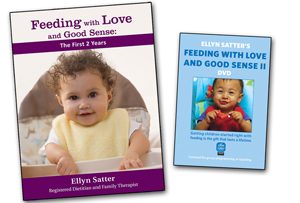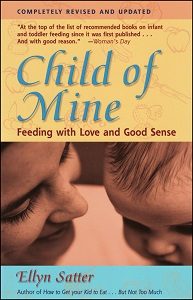

Family Meals Focus
The Ellyn Satter Institute Newsletter
Baby-led weaning
by Ellyn Satter, Registered Dietitian and Family Therapist
To work your way through the continual changes of introducing solid foods in a “baby-led” fashion, go by what your baby can do, not how old she is. Toward the middle of the first year, your baby may show signs of readiness for solid foods: she will take an interest in the world, sit up, and open her mouth when she sees something coming. From then on, she will gradually learn to eat solid foods. After a few weeks or months, she will join you at family meals and finger feed herself soft table food.
“Weaning” is the transition phase in infant feeding
A reader wants to know what I think of baby-led weaning. My answer is that from birth, feeding according to Satter’s Division of Responsibility in Ffeeding (sDOR) is baby-led, so naturally I think it is good. “Weaning” is another word for the transition phase in infant feeding, when babies shift, based on their developmental readiness, from being entirely nipple fed, through being introduced to semi-solid food, to joining in with family meals. A precocious child can make the transition from semi-solid through thick-and-lumpy to finger food in a month or two. Some children can’t be bothered with spoon-feeding, even when parents offer food appropriately and don’t get pushy. Those can’t-be-bothered babies don’t get interested in eating solid foods until they can finger feed themselves soft family food. A cautious, skeptical, or developmentally delayed child might start eating from the spoon at the standard 5 to 7 months and still take a year or more to gain enough oral-motor capability and comfort with tastes and textures to finger-feed herself soft family food. On the other hand, that child could be months older before she shows signs of developmental readiness for solid foods.
The book, Baby-Led Weaning (BLW), is one-size-fits-all
But of course, I am being deliberately obtuse. I am well aware that my reader wants me to discuss baby-led-weaning in the book sense. BLW recommends skipping spoon feeding and waiting to begin the feeding transition until the baby can finger feed herself, not soft family food, but sticks of soft food (teething biscuits or specially made food from recipes in the book). In short, if you follow sDOR and move through the transition in feeding based on information coming from your child, BLW is a footnote describing one part of the process – initiating finger-feeding – and giving food suggestions.
Being responsive with spoon-feeding keeps the baby in control of her eating
To work your way through the continual changes of the transition phase in a “baby-led” fashion, go by what your baby can do, not how old s/he is.
BLW claims that “being spoon fed by someone else means the baby is not in control of how much she eats.” Absolutely not true. Your being responsive with spoon-feeding keeps your baby in control of her eating. But this erroneous assumption is nonetheless reflected in published investigations. Mothers who follow the BLW protocol claim to be less anxious about feeding,1 less controlling,2 and more child-directed3 than “spoon-feeding” mothers. However, the research is pretty biased. The information comes from surveys done, not on randomly selected mothers, but on mothers who volunteered for study based on their allegiance to BLW. Moreover, questionnaires were not validated. That is, they were not evaluated to be sure they tested what they purported to test. The “baby-led” mothers were older, better educated, and more likely to hold professional jobs. If they were indeed less anxious and controlling, was it because they were older and more economically secure? In other words, survey information may or may not tell us what we want to know about mothers who do what they describe as baby-led weaning. In another study, poorly controlled retrospective inquiries show toddlers weaned using so-called baby-led weaning versus spoon-feeding to have a higher incidence of underweight, less overweight, and to prefer starches (compared with spoon-fed infants’ preferring sweets).4 Given the methodology, this, like the other studies, has to be regarded as more of a hope than a reality.
Introducing solid foods: fun and games or a source of anxiety?
BLW claims their approach reduces parental anxiety about introducing solid food. Whether or not that is true, it raises an important point. Many parents, particularly those who have children with special needs, are anxious about introducing solid foods. However, other parents find solid feeding to be fun and rewarding. What makes the difference? Are the relaxed parents better educated about feeding based on information coming from their child? While parents in publicly funded programs have access to feeding information, parents in the private sector generally do not. What they get, instead, is instructions to breastfeed exclusively for six months,5 along with conflicting information and expectations from friends, family, and a myriad of health care professionals. Such instructions make parents ignore their baby and doubt their own judgment. Parents care deeply about doing the right thing for their babies. Giving parents inaccurate, rigid, and conflicting advice increases their anxiety, makes it difficult for them to tune in on their baby, and sets the stage for unpleasant feeding.
To start solid food well, follow sDOR and feed based on what you baby can do
There is an authoritative, simple, one-size-fits-all set of directions that cuts through all of the conflicting advice, and it is this: Follow the Division of Responsibility in Feeding and feed based on what the baby can do, not how old s/he is. The child’s development and oral-motor capability provide the only trustworthy guides for starting and progressing solid foods. Education and materials must teach parents to observe their child and feed in the way that their baby tells them. That is the overarching theme in Child of Mine. Ellyn Satter’s Feeding with Love and Good Sense II Videos concretely demonstrate observing and understanding information coming from the child. The booklet, Feeding with Love and Good Sense: The First Two Years is such a guidebook. The articles on the ESI website, Child Feeding Ages and Stages, teach observation-based, stage-related feeding. Many early childhood programs contract with ESI for training on practical and developmentally appropriate feeding, and purchase our written and video-based materials. Some of them generate their own materials, and that is fine, provided they make information coming from the child the final authority with respect to guiding the feeding process. Within that context, it is contradictory and undermining to give rules about how long to exclusively breastfeed and when to start and progress solids.
References
- Brown A, Lee M. An exploration of experiences of mothers following a baby-led weaning style: developmental readiness for complementary foods. Matern Child Nutr. Nov 28 2011.
- Brown A, Lee M. Maternal control of child feeding during the weaning period: differences between mothers following a baby-led or standard weaning approach. Matern Child Health J. Nov 2011;15(8):1265-1271.
- Brown A, Lee M. A descriptive study investigating the use and nature of baby-led weaning in a UK sample of mothers. Matern Child Nutr. Jan 2011;7(1):34-47.
- Townsend E, Pitchford NJ. Baby knows best? The impact of weaning style on food preferences and body mass index in early childhood in a case–controlled sample. BMJ Open. January 1, 2012 2012;2(1).
- BREASTFEEDING SO. Breastfeeding and the Use of Human Milk. Pediatrics. March 1, 2012 2012;129(3):e827-e841.
Explore
For a brief, sensible, and entertaining guide to feeding, read Ellyn Satter’s Feeding with Love and Good Sense: The First Two Years. To see what good feeding looks like as well as to read about it, see Ellyn Satter’s Feeding with Love and Good Sense DVD II. For the home use version, click here.
To understand your child’s development and feed in the way that is right for her, read Ellyn Satter’s Child of Mine: Feeding with Love and Good Sense.
Related issues of Family Meals Focus
More about feeding
- Follow Satter’s Division of Responsibility in Feeding
- Avoid pressure
- Avoid restriction
- Evitando la Presión
- Child-feeding ages and stages
- Children know how much they need to eat
- Family-friendly feeding tips
- How children become competent eaters
- How children learn to eat new food
- Sit-down snacks
- Using “forbidden” food


